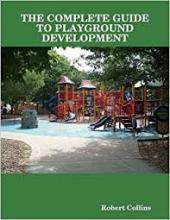
The Complete Guide to Playground Development was written by Robert Collins and published by RGC Design in 2008. The book serves as a manual to guide the playground development process of commercial and public use playgrounds from design to final construction.
Chapter 1 – General Playground Information begins the book with a study of the basics of play and the playground industry. For the purposes of the book, play is defined as “the act of engaging in self-directed physical recreation in a space defined for such activity.”1 Five types of play are briefly described: motor/physical play, social play, constructive play, fantasy play, and games with rules. Three forms of play are also outlined: solitary play, parallel play, and group play. In the playground industry, play is divided into activities that typical playground equipment is designed to accommodate: sliding, climbing, brachiating, swinging, balancing, bouncing or jumping, spinning, running, and imaginative or role playing.
Playground industry organizations that guide the standards of the industry are outlined. International Play Equipment Manufacturers Association (IPEMA) provides third party testing and certification of playground equipment. Design and safety are governed by the U.S. Consumer Product Safety Commission (CPSC), ASTM International (ASTM), and The Americans with Disabilities Act (ADA) with standards and guidelines that must be met for commercial playground projects. Many states also have their own regulations for playgrounds.
Chapter 2 – Define your Playground’s Scope outlines the importance of clearly defining what the playground is desired to be. This includes the desired play program and the limiting factors. The elements to consider in determining the scope of the play program include: the age range(s) to accommodate; the types of general play events to incorporate and those not to incorporate; the level of ADA accommodation desired; the site amenities to include; and the surfacing and curbing to be used. The limiting factors to consider include the budget available and the site conditions. Worksheets are included in this chapter to aid with listing the play program and limiting factors for a playground project.
Chapter 3 – Determine Budget Requirements and Funding Options begins with a general budget range chart based on 2008 prices. The age ranges of the children playing on the playground along with the sizes of the play area determine the costs for ADA-compliant equipment, site amenities, surfacing, and curbing. The rough estimations given are designed to give a budget framework for the playground planners. If the estimated costs surpass the allotted budget, then efforts to raise additional funds might be needed, such as obtaining grants, fundraising programs, community donations, and sponsorships. Other options could be a reduction in the play program’s scope or a separation into phases to allow implementation to take place over a number of years as the budget allows.
Chapter 4 – Select Your Playground Equipment and Surfacing begins with the Request for Proposal (RFP) that is sent to playground equipment vendors that outlines the details of the equipment, surfacing, and site amenities desired as well as a description of the site conditions for the playground. The playground planners should narrow down the options received to make a final selection of the vendor and equipment.
Chapter 5 – Determine Site Amenities suggests that site amenities might be determined separately from the playground equipment and surfacing RFPs. Asking for proposals from other vendors than the one chosen for the equipment and surfacing may offer amenities more suited to the project’s needs.
Chapter 6 – Finalize Playground Design brings the design process to the final plans for the installation and construction phase of the project. Any site improvements may involve a landscape architect to prepare plans for construction. The installation costs can be estimated and added to the costs of the playground equipment and surfacing.
Chapter 7 – Select Playground Installation Method includes the possible ways to install playground equipment by finding a playground contractor to do the work professionally or by using volunteers who build the playground under supervision of an experienced installer. Requesting bids from playground contractors is suggested especially for commercial playground projects.
Chapter 8 – Inspect and Certify Installation describes the inspection process of the newly installed playground equipment before the playground is opened to the public. The inspector should provide a punchlist of any items that need to be addressed to complete the installation satisfactorily. A letter should be received stating that the equipment is installed per the manufacturer’s specifications and is suitable for use upon completion of the construction. A Certified Playground Safety Inspector (CPSI) can also recommend a maintenance and inspection program for the playground.
Chapter 9 – Opening Day! describes the opening day ceremonies that can be done to celebrate the accomplishment of the planners, fundraisers, and all involved in the successful playground project.
The book concludes with a list of playground resources and some sample playground design drawings.
- 1. Collins, Robert. The Complete Guide to Playground Development. RGC Design. 2008. p. 3.

